
A couple years ago, I tried a recipe for a pesto sauce made with arugula and kalamata olives. It was delicious. The nutty, peppery bitterness of the arugula was well balanced by the briny olives. I’d been thinking about that recipe ever since. Recently, when I had a little arugula I had grown myself, plus a nice bunch that had been grown locally, I found out why I hadn’t made arugula pesto a second time. I had lost the recipe.
 Since I have a pretty firm grasp of the theory of pesto (I make basil pesto every summer), and I remembered the two most important ingredients (fresh arugula and kalamata olives), I was able to put together something that was probably pretty close to the original. I included some toasted almonds to give the sauce body. Walnuts would probably be just as good, if not even better. I also added
Since I have a pretty firm grasp of the theory of pesto (I make basil pesto every summer), and I remembered the two most important ingredients (fresh arugula and kalamata olives), I was able to put together something that was probably pretty close to the original. I included some toasted almonds to give the sauce body. Walnuts would probably be just as good, if not even better. I also added  some flat leaf parsley to tame the arugula a bit, and whirled everything together in the food processor with some decent extra virgin olive oil. The result was pretty close to the original recipe or at least close to what I can remember, which is close enough.
some flat leaf parsley to tame the arugula a bit, and whirled everything together in the food processor with some decent extra virgin olive oil. The result was pretty close to the original recipe or at least close to what I can remember, which is close enough.I not only served this sauce with pasta, but I also stirred some into a pan of white beans simmered with garlic (about 1/3 cup in 3 cups
 of beans). I topped both dishes with crumbled feta cheese, which tasted like it was born to be there. This pesto probably could be spread on garlic bread or sandwiches, or maybe even whisked into a vinaigrette served over milder salad greens or spring vegetables. Or how about potatoes? Well, the pesto will last for a few days in the refrigerator (I haven’t tried freezing it, but that might work, too), so I can try them all. Then, if I can get my hands on some more arugula, I can try some more! And since the recipe is now recorded here, I should never lose it again!
of beans). I topped both dishes with crumbled feta cheese, which tasted like it was born to be there. This pesto probably could be spread on garlic bread or sandwiches, or maybe even whisked into a vinaigrette served over milder salad greens or spring vegetables. Or how about potatoes? Well, the pesto will last for a few days in the refrigerator (I haven’t tried freezing it, but that might work, too), so I can try them all. Then, if I can get my hands on some more arugula, I can try some more! And since the recipe is now recorded here, I should never lose it again!
Arugula Pesto with Kalamata Olives
1/3 cup chopped almonds
2 cups (loosely packed) arugula leaves, any tough stems trimmed
1 cup (loosely packed) parsley leaves and tender stems
¼ cup pitted kalamata olives, coarsely chopped
¾ teaspoon salt
1/8 teaspoon freshly ground black pepper
1/3 cup chopped almonds
2 cups (loosely packed) arugula leaves, any tough stems trimmed
1 cup (loosely packed) parsley leaves and tender stems
¼ cup pitted kalamata olives, coarsely chopped
¾ teaspoon salt
1/8 teaspoon freshly ground black pepper
¼ cup extra-virgin olive oil
1. Place the almonds in a small skillet over medium heat. Heat, stirring often, until just beginning to brown. Be very careful not to burn them. Remove from the heat and cool completely.
1. Place the almonds in a small skillet over medium heat. Heat, stirring often, until just beginning to brown. Be very careful not to burn them. Remove from the heat and cool completely.
2. Place the cooled almonds in a food processor and pulse until coarsely but evenly ground.
 3. Add the arugula, parsley, olives, salt and pepper to the food processor. Process until everything is well ground into a coarse paste.
3. Add the arugula, parsley, olives, salt and pepper to the food processor. Process until everything is well ground into a coarse paste.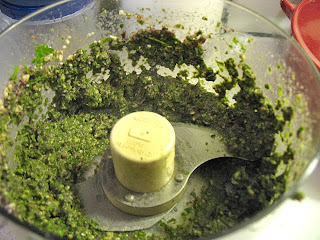 4. With the processor running, slowly add the olive oil and process until completely smooth. Your processor should have a feed tube or opening at the top to allow you to do this. (Add a little more olive oil if the pesto is too thick.)
4. With the processor running, slowly add the olive oil and process until completely smooth. Your processor should have a feed tube or opening at the top to allow you to do this. (Add a little more olive oil if the pesto is too thick.)
Makes about 1 ½ cups
To serve, toss with hot pasta, thinning with a little pasta-cooking water if desired. You can also stir it into cooked beans, spread it on breads or add it to dressings.
Other recipes like this one: Basic Basil Pesto
To serve, toss with hot pasta, thinning with a little pasta-cooking water if desired. You can also stir it into cooked beans, spread it on breads or add it to dressings.
Other recipes like this one: Basic Basil Pesto


 I am now much more vigilant against the fast food fall-back and, while we still joke about whether we’re going to actually eat the noodles and vegetables in their spicy peanut sauce as planned, I’ve rarely dropped the ball on this one in recent years. It is a relatively simple dish, although the sauce may seem to have a
I am now much more vigilant against the fast food fall-back and, while we still joke about whether we’re going to actually eat the noodles and vegetables in their spicy peanut sauce as planned, I’ve rarely dropped the ball on this one in recent years. It is a relatively simple dish, although the sauce may seem to have a


 You would think that the idea of spring would be thrilling enough in the upper Midwest. Warmer, longer days, lack of snow, green grass and lilacs are like paradise after the long, cold winter. But then comes the food-lover’s gift of spring, the morel mushroom, with its elusive nature and delicate floral and nutty flavor.
You would think that the idea of spring would be thrilling enough in the upper Midwest. Warmer, longer days, lack of snow, green grass and lilacs are like paradise after the long, cold winter. But then comes the food-lover’s gift of spring, the morel mushroom, with its elusive nature and delicate floral and nutty flavor.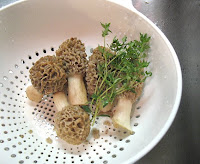

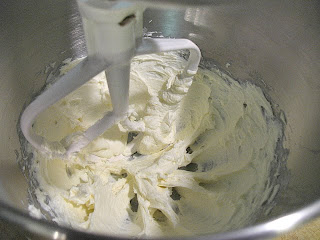



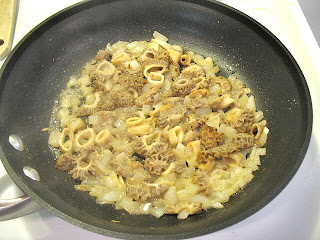









 2. Slowly whisk in the milk. Try to keep the flour mixture (roux) from forming lumps. Cook, keeping the heat at about medium-low and stirring or whisking frequently, until the mixture comes to a boil and thickens. Add salt, pepper and nutmeg. Remove from heat and set aside.
2. Slowly whisk in the milk. Try to keep the flour mixture (roux) from forming lumps. Cook, keeping the heat at about medium-low and stirring or whisking frequently, until the mixture comes to a boil and thickens. Add salt, pepper and nutmeg. Remove from heat and set aside.



 7. Fold the beaten egg whites into the base mixture, preferably with a rubber spatula or wide, flat spoon. To do this, spoon about one third of the whites at a time onto the base. Cut down through the whites with the edge of the spatula and turn it to bring some of the base up over the whites. Gently stir this way until the whites are incorporated with the base, leaving a puffy mixture. Try not to deflate the egg whites.
7. Fold the beaten egg whites into the base mixture, preferably with a rubber spatula or wide, flat spoon. To do this, spoon about one third of the whites at a time onto the base. Cut down through the whites with the edge of the spatula and turn it to bring some of the base up over the whites. Gently stir this way until the whites are incorporated with the base, leaving a puffy mixture. Try not to deflate the egg whites. 8. Spoon the mixture into the buttered soufflé dish. Bake at 375 F for 35 minutes or until the soufflé has puffed up significantly, but is still a bit wobbly if very gently shaken and the top is golden brown. Serve immediately.
8. Spoon the mixture into the buttered soufflé dish. Bake at 375 F for 35 minutes or until the soufflé has puffed up significantly, but is still a bit wobbly if very gently shaken and the top is golden brown. Serve immediately.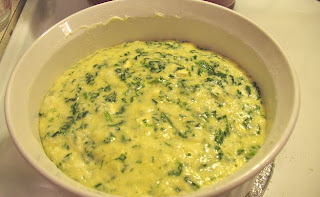

 When I had the good fortune to speak briefly with Michael Pollan after
When I had the good fortune to speak briefly with Michael Pollan after 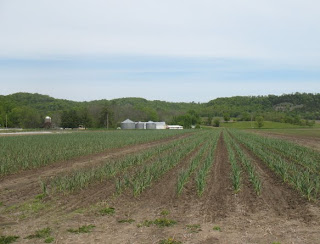





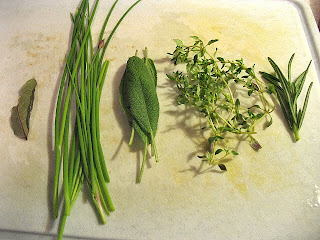 I usually try to keep these plants alive over the winter in a spare room, but this never works, and most of them die. That just means I get to shop for more herbs in the spring, which is what I did recently. This year, I’m trying not to go overboard and plant more than I can use, but we’ll see how that goes. Of course, as soon as I
I usually try to keep these plants alive over the winter in a spare room, but this never works, and most of them die. That just means I get to shop for more herbs in the spring, which is what I did recently. This year, I’m trying not to go overboard and plant more than I can use, but we’ll see how that goes. Of course, as soon as I 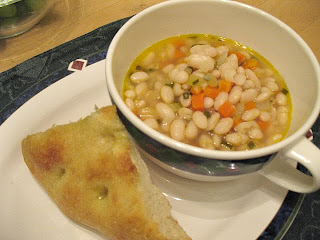 I had been waiting since my previous herb plantings met their demise to make a white bean soup with lots of herbs that I came up with last year, and the few cold and rainy days we had provided the perfect opportunity. I love white beans with herbs, especially sage, rosemary and thyme, and lots of garlic never hurts such a concoction. Add the usual carrot, onion and celery and simmer it all in broth and it’s soup. But it’s more than soup, really. It’s creamy white beans and perky, flavorful herbs that were picked less than an hour before they are eaten.
I had been waiting since my previous herb plantings met their demise to make a white bean soup with lots of herbs that I came up with last year, and the few cold and rainy days we had provided the perfect opportunity. I love white beans with herbs, especially sage, rosemary and thyme, and lots of garlic never hurts such a concoction. Add the usual carrot, onion and celery and simmer it all in broth and it’s soup. But it’s more than soup, really. It’s creamy white beans and perky, flavorful herbs that were picked less than an hour before they are eaten.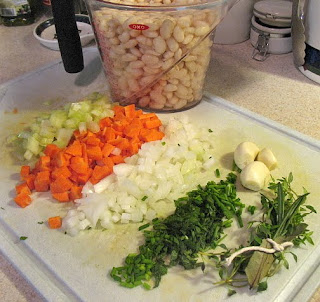 Usually when I make this, the ingredient list (in my head) reads more like “a big carrot, a couple ribs of celery, some onion, a handful of herbs from the porch, some broth (chicken is a little better, but vegetable will do) and some beans. Season to taste.” Well, since I’m now excited enough about this soup to post it to The Messy Apron, I tried to put some more discreet quantities in the recipe below. You can play a little fast and loose with most of the ingredients and use whatever herbs you have or like. I used sage, chives, rosemary, thyme and a dried bay leaf. (I think the sage is absolutely essential with white beans.) The sage and chives, I minced and added directly to the broth, and the rosemary, thyme and bay leaf I tied together into a bouquet garni and removed them when the soup was done. It saves the trouble of de-leafing the thyme or having to chew on rosemary leaves, but still gets the flavors of those herbs into the soup.
Usually when I make this, the ingredient list (in my head) reads more like “a big carrot, a couple ribs of celery, some onion, a handful of herbs from the porch, some broth (chicken is a little better, but vegetable will do) and some beans. Season to taste.” Well, since I’m now excited enough about this soup to post it to The Messy Apron, I tried to put some more discreet quantities in the recipe below. You can play a little fast and loose with most of the ingredients and use whatever herbs you have or like. I used sage, chives, rosemary, thyme and a dried bay leaf. (I think the sage is absolutely essential with white beans.) The sage and chives, I minced and added directly to the broth, and the rosemary, thyme and bay leaf I tied together into a bouquet garni and removed them when the soup was done. It saves the trouble of de-leafing the thyme or having to chew on rosemary leaves, but still gets the flavors of those herbs into the soup.
